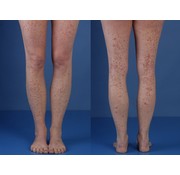Antistreptolysin titer (AST) streptococci
Antistreptolysin titer (AST).
The AST (antistreptolysin titer) is used to determine if there has been an infection with the beta-hemolytic streptococcus. This test is done in skin infections or skin reactions to streptococci and in acute rheumatoid arthritis or kidney filtration. For example, in the case of a damaged leg where one thinks of and erysipelas in the recent past, but where it has not been proven. Or with skin reactions that may be caused by streptococcus, such as scarlet fever, and psoriasis or and shedding.
A titer higher than 200 U/ml indicates infection.
A blood test for streptococcus A can be done after about 2 to 5 days from the first symptoms. It takes several days for the body to produce enough antibodies that can be detected in the blood. Some people can be infected with streptococcus A without having symptoms, so a blood test can also be done if infection is suspected without symptoms being present.
Throat and tonsillitis due to GAS usually go away on their own in a week.
Scarlet fever usually heals on its own within 10 days.
The spots may still be slightly visible and slowly disappear. Hands and feet may begin to peel.
Shingles go away within 1 to 3 weeks. No scars are left behind.
Antibiotics can make it go away sooner.
If you have erysipelas, you get antibiotics right away.
If you have puerperal fever, you also get antibiotics right away for 14 days.
If you have inflammation of the kidneys or joints, for example, you often have to take antibiotics for years.
Very serious inflammations of the kidneys, bones, heart and brain are treated in a hospital. Sometimes a person can heal quickly if given antibiotics quickly. Sometimes someone has to stay in the hospital for a long time, such as with brain (membrane) inflammation with coma.
For acute reasons for serology please see a physician!
as in acute rheumatoid arthritis, post-streptococcal glomerulonephritis and atypical presentations of streptococci.
AST (antistreptolysin O-titer): titer increases between 1-4 wk after infection and decreases after 3-6 mn. An increased titer or titer rise is consistent with a recent infection. Especially in skin infections, the AST may remain negative and determination of anti-DNAseB is useful.
anti-DNAse B: becomes positive slightly later than the AST and remains positive longer. In post-streptococcal images, the AST is often negative and anti-DNAse B positive.
Beta-hemolytic streptococci and Streptococcus pyogenes (also known as streptococcus A) are both types of bacteria belonging to the Streptococcus family. The main difference between these two types of bacteria is their ability to hemolysis (break down) red blood cells.
Beta-hemolytic streptococci are bacteria capable of hemolysing red blood cells, resulting in a hemolytic (blood-degrading) halo around the bacteria in a culture medium. This type of streptococcus can cause several diseases, including pneumonia, blood poisoning and skin infections.
Streptococcus pyogenes (streptococcus A) is a specific species of beta-hemolytic streptococcus responsible for several infections, including streptococcal angina (tonsillitis), skin infections (such as impetigo) and subcutaneous infections (such as cellulitis).
In short, beta-hemolytic streptococci are a broader group of bacteria that can break down red blood cells, while streptococcus A is a specific species responsible for a limited number of infections.





